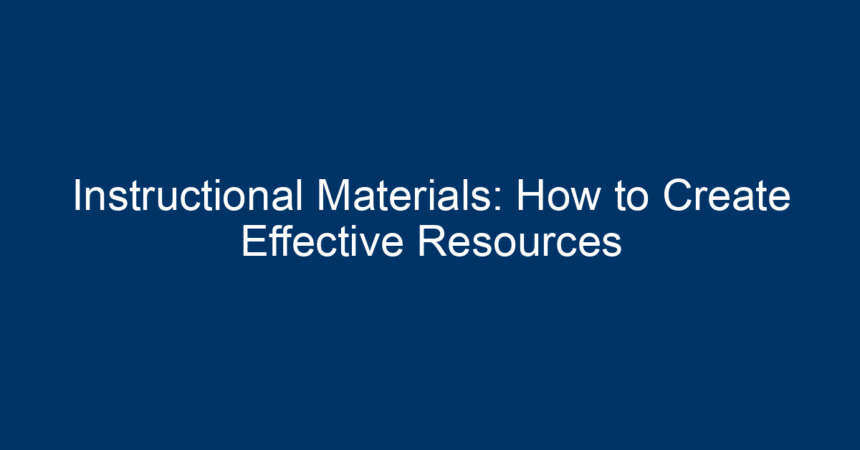Creating effective instructional materials is a vital aspect of teaching that can significantly enhance student learning outcomes. Whether you’re an educator, corporate trainer, or instructional designer, well-crafted resources can make complex topics engaging and digestible. This article will guide you through the process of designing effective instructional materials that capture and retain learner interest while delivering crucial knowledge.
Understanding Instructional Materials
What Are Instructional Materials?
Instructional materials encompass a broad range of resources tailored to facilitate learning. This includes textbooks, worksheets, multimedia presentations, online courses, and even hands-on activities. The intent behind these materials is to provide students with a structured approach to learning that enhances their understanding and retention of the subject matter.
The Importance of Effective Instructional Materials
Effective instructional materials serve multiple purposes. They not only help in conveying information but also engage students actively in the learning process. When properly designed, these resources can:
- Increase student motivation
- Foster critical thinking skills
- Create a supportive learning environment
- Cater to diverse learning styles
With the rise of digital learning and remote education, the need for highly effective instructional materials has become even more pressing.
Key Principles for Designing Instructional Materials
1. Know Your Audience
Understanding your learners is critical. Assess their age, educational background, learning preferences, and needs. This information will help you tailor your instructional materials to be more effective. For instance, younger students might prefer colorful visuals and interactive activities, while adult learners may benefit from case studies and practical applications.
2. Set Clear Objectives
Every piece of instructional material should have specific learning objectives. Ask yourself what you want your audience to achieve by the end of the lesson or course. Clear objectives provide a roadmap for both instructors and learners, ensuring that everyone is aligned on the goals.
3. Incorporate Diverse Learning Styles
Different individuals absorb information in various ways. According to the VARK model, learners typically fall into four categories: Visual, Auditory, Reading/Writing, and Kinesthetic. Your instructional materials should include:
- Visuals: Charts, infographics, and videos.
- Auditory Elements: Podcasts, discussions, or recorded lectures.
- Textual Resources: Articles, manuals, or written assignments.
- Kinesthetic Activities: Hands-on projects or simulations.
4. Use Engaging Content
The content you choose must be relevant and engaging. When selecting materials, consider the following:
- Current events related to the topic
- Real-world applications
- Case studies or examples from expert sources
- Interactive elements, such as quizzes or games
5. Prioritize Clarity and Simplicity
Avoid jargon and overly complex language unless absolutely necessary. The goal is to make information accessible. Use bullet points, charts, and visuals to break down complex ideas into digestible parts. Clear and simple language encourages better understanding and retention.
Types of Instructional Materials
1. Printed Materials
Printed resources like textbooks, workbooks, and handouts can be highly effective. These materials can include illustrations, diagrams, and step-by-step procedures. Always ensure that printed materials are well-organized and visually appealing to enhance their effectiveness.
2. Digital Resources
In today’s digital age, online resources have gained popularity. These can range from eBooks and podcasts to interactive e-learning platforms. Digital materials have the added benefit of being easily updated and distributed, making them versatile for various learning environments.
3. Multimedia Presentations
Videos and slide presentations can enhance understanding significantly. Incorporating audio-visual aids caters to visual and auditory learners while reinforcing key concepts. Make sure your media is high quality and relevant to the topic.
4. Interactive Activities
Hands-on activities can cement learning. This could range from labs for science classes to role-playing exercises for language learners. Interactive materials help students apply concepts in real-time, enhancing understanding and retention.
5. Assessments and Feedback Tools
Assessment materials, such as quizzes and feedback forms, are crucial for measuring student understanding. Create assessments that reflect the objectives outlined and provide immediate feedback to facilitate improvement.
The Creation Process
1. Brainstorm Ideas
Before you start creating instructional materials, brainstorm ideas that align with your learning objectives. Consider using mind maps to visualize connections between key concepts. Involve colleagues or potential learners in this discussion to gather diverse perspectives.
2. Draft and Design
Once you’ve outlined your ideas, begin drafting the materials. Pay attention to layout, design, and overall flow. Aim for consistency in fonts, colors, and styles to create a professional appearance.
3. Review and Revise
After drafting, review your materials critically. This could involve peer reviews or pilot testing with a small group of learners. Gather feedback to identify any areas for improvement and make necessary revisions.
4. Implement
Once your materials are polished, implement them in your educational environment. Monitor how students interact with the resources and be open to making adjustments based on their needs.
5. Reflect and Adapt
Post-implementation, take the time to reflect on what worked and what didn’t. Ask for feedback from students and peers, and be proactive in refining your instructional materials for future use.
Best Practices for Effective Instructional Materials
1. Consistent Branding
If you’re creating materials for a school or organization, maintain consistent branding throughout your resources. This reinforces identity and professionalism, making the materials easily recognizable.
2. Accessibility
Make sure your instructional materials are accessible to everyone, including individuals with disabilities. This could involve providing alternative text for images, captions for videos, and ensuring that color choices meet accessibility standards.
3. Continuous Improvement
Stay informed about current trends in education and instructional design. Embrace continuous learning by attending workshops or online courses focused on creating effective instructional materials.
Conclusion: Key Takeaways
Creating effective instructional materials is an essential skill in the realm of education and training. By understanding your audience, setting clear objectives, incorporating diverse learning styles, using engaging content, and prioritizing clarity, you can craft resources that significantly enhance the learning experience.
Remember, the goal isn’t just to deliver content but to create a rich learning environment that cultivates understanding and curiosity. As you embark on your journey to create instructional materials, keep the principles outlined in this article in mind and remain adaptable, open to feedback, and committed to continuous improvement. Your efforts can make a lasting impact on learners, fostering not just knowledge but a lifelong love of learning.




